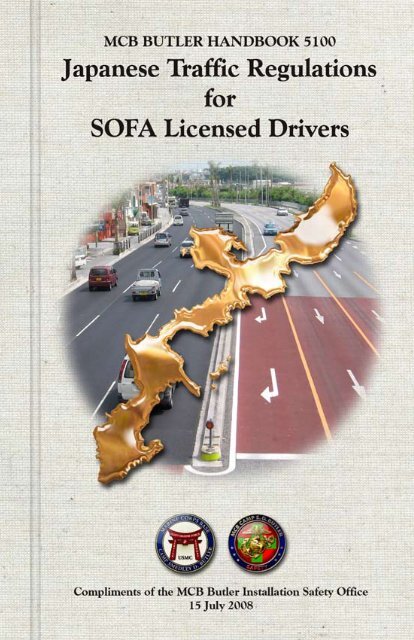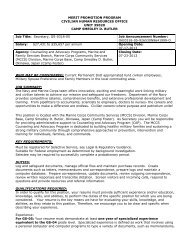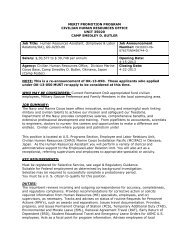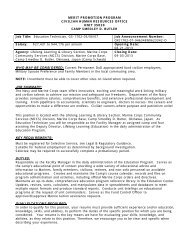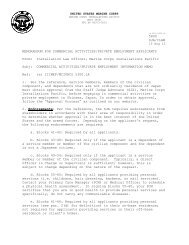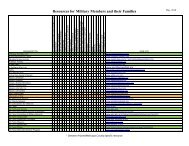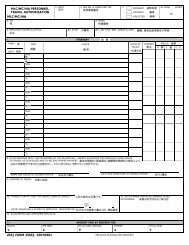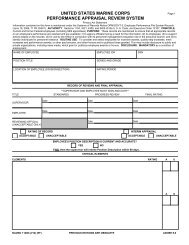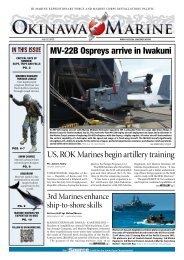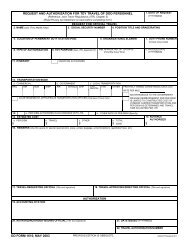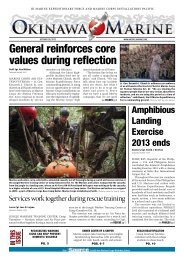Download Okinawa Drivers Manual
Download Okinawa Drivers Manual
Download Okinawa Drivers Manual
Create successful ePaper yourself
Turn your PDF publications into a flip-book with our unique Google optimized e-Paper software.
CONTENTS<br />
Introduction ................................................................................................................3<br />
Section I: Japanese Traffic Regulations Overview<br />
Traffic Lanes ..............................................................................................................4<br />
Common Rules of the Road .......................................................................................5<br />
Common Traffic Rules for Motor Vehicles on National Expressways and Exclusive<br />
Motor Vehicle Roadways ...........................................................................................5<br />
Speed Limits ..............................................................................................................6<br />
Overtaking and Passing .............................................................................................7<br />
Parking and Stopping ................................................................................................8<br />
Roadway Intersections ..............................................................................................9<br />
Vehicle Signaling ......................................................................................................10<br />
Use of Vehicle Horn ..................................................................................................10<br />
Headlight use During Inclement Weather .................................................................10<br />
Vehicle Maintenance Requirements ..........................................................................10<br />
Vehicle Operator Permits and Associated Documents ..............................................10<br />
Pedestrians ................................................................................................................15<br />
Vehicle Accidents .....................................................................................................15<br />
On-Base Traffic Point System ..................................................................................16<br />
Off-Base Ticketing and Fines ...................................................................................16<br />
Important Safety Reminders .....................................................................................16<br />
Section II: Common Japanese Traffic Signs ............................................................18<br />
Section III: Other Japanese Traffic Signs ................................................................27<br />
2
INTRODUCTION<br />
1. Purpose. This handbook covers common elements of U.S. and Japanese traffic<br />
regulations and laws where applicable, for Status of Forces Agreement (SOFA)<br />
sponsored U.S. Armed Forces personnel, government civilian employees, dependents<br />
and contractors while operating motor vehicles on mainland Japan and <strong>Okinawa</strong>.<br />
2. General<br />
a. The operation of privately owned vehicles (POV) within Japan is considered a<br />
privilege and has been coordinated between U.S. Forces Japan and the Japanese<br />
Provincial Government. Like all high-level agreements of this nature, adherence<br />
to local laws and regulations are critical to ensure the agreement remains in good<br />
standing. Personnel should be aware that driving is a privilege that can be revoked<br />
through formal Traffic Court adjudication, or simply through command administrative<br />
action based on the desires and needs of the commander.<br />
b. The operation of a motor vehicle within Japan carries with it similar responsibilities<br />
(and consequences) as operating a motor vehicle in the U.S. with a few exceptions. A<br />
significant difference under Japanese law involves categorizing anyone with a motor<br />
vehicle operator’s license as a “professional driver.” While driving in the U.S. is more<br />
or less taken for granted these days for anyone 16 years of age or older, Japanese citizens<br />
must devote considerable time and money toward obtaining their license through a<br />
government approved professional driving school. As such, traffic accidents that result<br />
in personal injury or death frequently lead to criminal prosecution under Article 211<br />
of the Japanese Penal Code, “Injury or Death through Occupational or Professional<br />
Negligence.” In mishaps of this nature, drivers who are in the least bit negligent may<br />
be charged. Penalties can be both costly and severe as at-fault drivers will typically<br />
be subject to the Japanese legal system under the existing SOFA. Additionally, under<br />
Japanese traffic law, SOFA licensed drivers are subject to steeper fines and more severe<br />
penalties for non-injury related traffic offenses such as DUI/DWI, speeding, and illegal<br />
parking.<br />
3. Traffic Signs. Traffic signs used throughout mainland Japan and <strong>Okinawa</strong> are<br />
considered international-standard road signs. This means if a vehicle operator has ever<br />
driven or been licensed anywhere outside the U. S., many of the road signs depicted in<br />
this handbook under Section II and III will likely be easily recognizable.<br />
4. Disclaimer. This handbook includes, where applicable, U.S. and USMC traffic safety<br />
regulations while operating motor vehicles aboard USMC camps and installations<br />
aboard <strong>Okinawa</strong> and mainland Japan. Personnel who operate motor vehicles aboard<br />
Kadena Air Force Base are also subject to the provisions of 18th Wing Instruction<br />
31-204, Kadena Air base Motor Vehicle Traffic Supervision. This handbook does not<br />
cover every possible scenario that a SOFA licensed driver may find themselves faced<br />
with when operating a motor vehicle on or off base. However, drivers are reminded to<br />
remain vigilant, drive defensively, and contact your local traffic safety professionals for<br />
further information when traffic conditions or changing laws and regulations require<br />
additional interpretation or guidance.<br />
3
1. Traffic Lanes<br />
JAPANESE TRAFFIC REGULATIONS<br />
OVERVIEW<br />
a. A primary traffic rule throughout Japan dictates that all vehicles (motorized or<br />
pedaled) remain to the far left side of the roadway where road conditions permit.<br />
However, vehicles may partially cross or fully cross-over multiple lanes to reach the<br />
far right side of the roadway under the following circumstances:<br />
(1) When traveling on multi-lane or one-way traffic only roadways.<br />
(2) Whenever the width of the left half of the road is insufficient for a vehicle<br />
to proceed.<br />
(3) Whenever a vehicle is unable to proceed on the left half of the road due<br />
to road damage, road construction work, or other impediments.<br />
(4) Whenever attempting to pass another vehicle on a road where the width<br />
of the left half is less than 6 meters and road conditions and visibility permit passing.<br />
turn.<br />
(5) When merging across multi-lane roadways in order to make a right-hand<br />
b. Vehicles may pass other vehicles under the conditions prescribed above when the<br />
center of the road is marked by a solid or broken WHITE line, however, crossing over<br />
the center line should be kept to a minimum. The following road markings prohibit<br />
passing:<br />
(1) Solid yellow centerline = No passing from either lane.<br />
(2) Double solid yellow centerline = No passing from either lane.<br />
(3) Solid yellow line next to a broken yellow centerline = No passing from<br />
the lane nearest the solid yellow line.<br />
Caution: When operating a vehicle at night during inclement weather, road markings<br />
and lane separation lines tend to “disappear” due to the type of traffic paint used on<br />
Japanese roadways.<br />
c. Whenever a sidewalk is separated from the roadway, vehicles must travel on the<br />
roadway. However, a vehicle may cross a sidewalk when this is the only way to enter<br />
or exit a business, private residence, or similar location. Pedestrians on sidewalks and<br />
crosswalks have the right of way at all times.<br />
d. Vehicles must not be driven into safety zones at any time.<br />
e. Lanes designated for specific types of vehicles (bus lanes for example), are required<br />
to travel in the specific lanes designated for that type of vehicle.<br />
4
f. Bus Priority Lanes are designated “priority” for public buses, school buses and taxi<br />
cabs. All other vehicles are required to move out of the lane immediately when a bus<br />
or taxi approaches from the rear.<br />
h. Bus exclusive lanes are for buses, taxicabs with passengers, and motorcycles. The<br />
only time POVs are allowed in the bus exclusive lane is to make a left turn. In this<br />
instance, you can move into the bus exclusive lane just prior to your turn, provided you<br />
do not interfere with a bus or taxicab’s right of way.<br />
i. When a public bus is signaling to leave a bus stop, no vehicle shall impede or<br />
interfere with the bus unless doing so means abruptly changing speed or traffic lanes<br />
which could cause an accident in an adjacent traffic lane.<br />
j. Motorcycles are restricted to the far left side of the roadway on highway 58 from<br />
Naha Port to Kadena except within 30 meters (100 feet) of making a right turn. Japanese<br />
traffic law requires all motorcycle operators and passengers to wear helmets regardless<br />
of the size of the motorcycle. In addition to wearing a helmet, USMC regulations<br />
require operators and passengers to wear a reflective vest on and off base. The vest<br />
must be reflective international orange and can be integrated as part of a specialized or<br />
custom motorcycle jacket if so desired. Reflective vests/material cannot be covered by<br />
an outer jacket or backpack when the motorcycle is operation.<br />
2. Common “Rules of the Road”<br />
a. All personnel operating or riding as a passenger in a motor vehicle shall wear a seat<br />
belt at all times on or off base while the vehicle is in operation.<br />
b. Vehicles will not enter any area of the roadway that is marked or blocked to impede<br />
motorized vehicle traffic.<br />
c. Vehicles must come to a complete stop at all stop lines when provided, and at<br />
pedestrian crosswalks (when occupied), or at uncontrolled intersections where stopping<br />
is required by law.<br />
d. When there are three or more adjoining lanes in the same direction of travel, the far<br />
right lane is considered the passing lane; however, vehicles can travel in any lane in<br />
accordance with posted speed limits weather and traffic conditions permitting.<br />
e. No vehicle may change its direction of travel without sufficient signaling the<br />
intention to do so regardless of whether a turning lane is provided or not.<br />
3. Common Traffic Rules for Motor Vehicles on National Motor Vehicle<br />
Expressways and Motor Vehicle Exclusive Roadways<br />
a. Motor vehicles entering the primary lane of travel on a National Expressway must<br />
use the speed acceleration lane if provided.<br />
b. Motor vehicles intending to exit an expressway must travel in the lane nearest the<br />
exit, or use the speed-deceleration lane if provided.<br />
5
c. Motor vehicles attempting to merge into a primary lane of travel must not obstruct<br />
the passage of vehicles already traveling in the primary lane of travel.<br />
d. It is the vehicle operator’s responsibility to ensure that a vehicle is mechanically<br />
sound, properly and fully serviced, and that cargo is properly and securely stowed prior<br />
to traveling on a national expressway or vehicle exclusive roadway. Violation of this<br />
requirement, either through negligent breakdown or cargo loss, may result in monetary<br />
fines and/or penal action (confinement).<br />
e. Should the need arise to stop a vehicle due to a malfunction or breakdown, the<br />
vehicle must be moved completely off the expressway and warning devices posted<br />
to clearly indicate that the vehicle is stopped for emergency or maintenance reasons.<br />
Warning devices, such as safety triangles and road flares, are available at AAFES<br />
service stations, MCCS car care centers, and off-base auto parts stores throughout<br />
Japan.<br />
f. Vehicles stopped on national expressways at night are required to display both<br />
parking lights and/or emergency flashers and road flares as needed. It is recommended<br />
that emergency flashers be used any time a vehicle is stopped along any type of roadway<br />
for any purpose.<br />
4. Speed Limits<br />
a. When operating a vehicle in Japan, speed is depicted in kilometers per hour rather<br />
than miles per hour. For example, a speed limit sign depicted as “50” means 50<br />
kilometers per hour not 50 miles per hour. Speedometers on all Japanese, and most<br />
European and U.S. made cars, depict kilometers per hour vice miles per hour, so<br />
complying with posted speed limits should not be difficult.<br />
b. Posted speed limits are significantly less than what most European and U.S. drivers<br />
are used to. However, the typical congested narrow roadways throughout Japan and<br />
<strong>Okinawa</strong> dictate that reduced speed limits must be observed in order to ensure public<br />
safety. Typical speed limits and associated miles per hour are as follows:<br />
KPH MPH<br />
20 12<br />
25 16<br />
30 19<br />
35 22<br />
40 25<br />
45 28<br />
50 31<br />
55 34<br />
60 37<br />
70 44<br />
80 50<br />
90 56<br />
100 62<br />
6
. The maximum speed limit for motor vehicles operating off U.S. Forces installations<br />
is as follows unless reduced speed limits are otherwise posted:<br />
(1) The maximum speed is 60 kilometers per hours for all trucks under 5<br />
tons, and all passenger vehicles (including buses and motorcycles with 25lcc engine<br />
displacement and higher).<br />
(2) The maximum speed is 50 kilometers per hour for all trucks over 5 tons,<br />
all special vehicles (cement trucks, wreckers), and motor cycles or scooters under<br />
25lcc.<br />
(3) The maximum speed is 30 kilometers per hour for any 2-wheeled vehicle<br />
under 51cc displacement.<br />
c. When traveling on national expressways and exclusive use roadways, vehicles will<br />
not be operated at less than the posted minimum speed limit unless it is unsafe to do so<br />
due to hazardous weather and/or road conditions.<br />
d. When following another vehicle, Japanese law requires that drivers maintain<br />
adequate separation distance to prevent colliding with the vehicle being followed in<br />
the event the vehicle makes an abrupt stop. The same is true when initiating a stop or<br />
turn. <strong>Drivers</strong> should avoid making sudden stops or last minute turns. A general rule<br />
of thumb is to apply a 2-second rule when driving conditions permit. To calculate the<br />
2-second rule, pick a stationary object along the roadway being traveled. Once the<br />
vehicle in front of you crosses that point, start counting. You should reach at least “2”<br />
before your vehicle reaches the same point. Note that highly congested urban areas<br />
will be difficult to apply this rule, so drivers must remain constantly vigilant when<br />
driving in these types of conditions.<br />
5. Overtaking and Passing. “Passing” means going around a slower vehicle to the<br />
right on a two-way roadway. “Overtaking” refers to one vehicle moving past a slower<br />
vehicle on a one-way or multi-lane roadway.<br />
a. Overtaking and passing violations account for a high percentage of motor vehicle<br />
mishaps in Japan due to the limited availability of dedicated passing lanes on typical<br />
roadways. Extreme caution must be used any time an attempt is made to overtake or<br />
pass a slower vehicle.<br />
b. Vehicles attempting to pass another vehicle must typically pass to the right of the<br />
vehicle being overtaken. Certain conditions permit passing on the left; multi-lane<br />
roadways for example, or when a vehicle in front of you is stopped or slowing its speed<br />
to make a right turn. Additional passing prohibitions include:<br />
(1) Passing a vehicle ahead of you if the vehicle indicates or appears to be in<br />
the process of passing another vehicle (dual passing).<br />
(2) Do not pass if the vehicle ahead is proceeding paralleled with and at the<br />
same speed as another vehicle (side by side).<br />
(3) <strong>Drivers</strong> shall not zigzag (cut) into lanes of traffic that are proceeding<br />
7
slowly or traffic that has stopped. This regulation not only applies at intersections, but<br />
any location along the roadway where traffic is proceeding at a slow pace.<br />
(4) Passing is also prohibited within 30 meters of a crosswalk or intersection,<br />
on blind curves, near the top of upgrades or on steep downgrades, inside tunnels (unless<br />
multi-lane roadway), at railroad crossings, and in designated “No Passing Zones” as<br />
marked by a posted traffic sign.<br />
6. Parking and Stopping<br />
a. “No Parking Zones” and/or “No Stopping Zones” are designated by posted traffic<br />
signs as depicted in Section II. <strong>Drivers</strong> are not permitted to stop or park at posted areas<br />
along the roadway expect under the following circumstances:<br />
(1) When executing a temporary stop to clear the lane of travel for an<br />
emergency vehicle, as directed by an uniformed police officer, or to avert danger.<br />
law.<br />
(2) Temporary stops at designated intersections or crosswalks as required by<br />
b. When parking meters are installed, drivers are required to activate the meter unless<br />
otherwise posted. If time limits are exceeded, vehicles may be towed. Recovering a<br />
vehicle after it has been towed can be costly and time consuming.<br />
c. Parking a vehicle in any of the following locations is considered a violation of<br />
Japanese law unless permission is granted beforehand by a local police box having<br />
jurisdiction over the proposed parking location:<br />
(1) Within 3 meters or less of a motor vehicle entrance or exit that provides<br />
access to a main roadway.<br />
(2) Within 5 meters or less of a fire station, side of a water source used for<br />
firefighting purposes, a fire hydrant, or a fire station’s fire truck entrance/exit road.<br />
(3) Within 1 meter or less of a fire alarm.<br />
(4) Within 5 meters or less of a roadway construction project.<br />
(5) All roadways within U.S. Forces installations are designated as fire lanes<br />
and parking on any roadway is prohibited except where otherwise posted or allowed<br />
by local regulations.<br />
(6) Parking on grass or bare terrain on U.S. Installations is prohibited unless<br />
where otherwise posted.<br />
d. No vehicle will be parked in any location where there is less than 0.5 meters of clearspace<br />
space between the vehicle and the roadway. This does not apply for temporary<br />
stops to load or unload cargo or people, when the driver leaves the vehicle temporarily<br />
(to purchase a soft drink or ice cream along the roadway), or to provide emergency<br />
response to a sick or injured person.<br />
8
e. Abrupt vehicle stops are to be avoided unless required to avert an accident.<br />
f. When a vehicle is stopped to take on or discharge people or load or unload cargo,<br />
it must be stopped as close as possible to the left edge of the roadway and in such a<br />
manner that the vehicle does not impede traffic.<br />
g. On a one-way street, and if so designated by a posted traffic sign, vehicles may be<br />
parked along the right side of the roadway.<br />
h. Designated parking spots may have police imposed time limits for continuous<br />
parking and vehicle operators need to verify time limits if parking a vehicle for an<br />
extended time period.<br />
i. A police officer may order that a vehicle be moved or parked in a different manner so<br />
as not to obstruct the flow of traffic. When the vehicle operator is not available, police<br />
may have the vehicle moved up to 50 meters from where it was originally parked to<br />
help prevent a hazardous condition. If moving the vehicle 50 meters does not solve<br />
the problem, the vehicle may be impounded. The vehicle operator assumes all costs<br />
associated with moving or impounding the vehicle.<br />
7. Roadway Intersections<br />
a. Vehicle right-of-way at uncontrolled intersections is observed as follows:<br />
(1) Vehicles traveling on a priority road have the right-of-way.<br />
(2) Vehicles traveling on a wider road have the right-of-way.<br />
(3) A vehicle approaching an intersection from left has the right-of-way over<br />
a vehicle approaching the intersection from the right.<br />
b. Any roadway with a centerline or traffic lane that crosses through an intersection is<br />
considered the priority road and vehicles traveling on this road have the right of way.<br />
c. <strong>Drivers</strong> entering or traveling through an intersection are required to pay attention to<br />
other vehicles in the intersection as well as pedestrians that may be in crosswalks in<br />
close proximity to the intersection.<br />
d. Vehicles shall not enter an intersection even if a traffic signal is green if doing so<br />
will block cross traffic due to stalled rush-hour traffic.<br />
e. Vehicles shall not enter crosswalks, railroad crossings, or any other portion of<br />
the road that may impede vehicle or pedestrian cross traffic due to stalled rush-hour<br />
traffic.<br />
f. Left turn on a red traffic light after a complete stop is prohibited off-installation<br />
unless permitted by a traffic control device (green signal arrow or a white sign with a<br />
blue arrow).<br />
9
g. Left turns on a red traffic light after a complete stop is permitted on-U.S. Installations<br />
unless otherwise posted.<br />
8. Vehicle Signaling. When making any type of lane change, or turn in any direction,<br />
vehicle operators are required to use either the vehicle’s turn signal or hand signal at<br />
least 30 meters prior to an intended turn or lane change. <strong>Drivers</strong> should ensure that<br />
vehicle signals have cancelled after the lane change or turn has been made.<br />
9. Use of Vehicle Horn. It is not acceptable to sound a vehicle’s horn unless where<br />
required by law or in an effort to avert a hazardous situation.<br />
10. Headlight use during Inclement Weather. Japanese traffic law does not require<br />
the use of headlights during periods of reduced visibility due to inclement weather.<br />
However, headlight use is mandatory aboard all U.S. installations and it’s highly<br />
encouraged for vehicle operators to use headlights during periods of reduced visibility<br />
on or off installation.<br />
11. Vehicle Maintenance Requirements. Under Japanese traffic law, police officers<br />
have the right to stop a vehicle when the vehicle does not appear to be mechanically<br />
sound or safe to be on the road. Police officers may also conduct an on-the-spot<br />
vehicle inspection and provide the vehicle operator with an itemized maintenance<br />
list. Police officers may also affix a sticker to the front of the vehicle, clearly visible<br />
to all, denoting that the vehicle is in need of maintenance. The sticker may not be<br />
removed or destroyed and can only be removed after all discrepancies to the vehicle<br />
have been repaired and certified. SOFA licensed drivers should note that vehicles must<br />
be inspected every two years and vehicles that pass this inspection must display an up<br />
to date inspection sticker in the vehicle’s windshield. Vehicles that do not pass this<br />
inspection, or vehicles with expired inspection stickers, are not allowed on the road.<br />
Contact the local vehicle registration office for further information.<br />
12. Vehicle Operator Permits and Associated Documents<br />
a. Vehicle Operator Permit. The USFJ Form 4 EJ is the only authorized form used for<br />
SOFA POV licensing purposes in <strong>Okinawa</strong> and mainland Japan. The form is issued<br />
on <strong>Okinawa</strong> at the MCB Installation Safety Office, located on Camp Foster (building<br />
5831) and at the 18th Security Forces Squadron Pass & ID office located aboard<br />
Kadena Air Force base (building 31). The license expires 3-years from date of issue,<br />
or upon revocation of SOFA sponsorship. Specific vehicle category endorsements<br />
such as motorcycle, bus, or heavy trucks require additional testing prior to the operator<br />
being granted an endorsement. Questions regarding specific endorsements should be<br />
addressed to the servicing licensing office.<br />
b. Requirements for Obtaining a USFJ Form 4 EJ Operator Permit. At a minimum,<br />
the specific requirements outlined below must be met before a USFJ Form 4 EJ will<br />
be issued. Waivers may be granted on a case by case basis based on the needs of the<br />
command and the individual being licensed.<br />
(1) Applicants must have SOFA status and a valid Identification Card.<br />
(2) Applicants must have either an international driver’s license, a valid<br />
10
operator’s permit issued by a State/U.S. Territory, or an OF 346 (U.S. Government<br />
Operator’s Permit). If the OF 346 is used, it must qualify the operator to drive 1 1/4<br />
ton vehicles or larger.<br />
(3) Family members must provide one of the following documents to verify<br />
SOFA status.<br />
permit.<br />
(a) Area Clearance.<br />
(b) Sponsor’s Permanent Change of Station Orders.<br />
(c) Proof of age. Applicants must be at least 16 to receive a learner’s<br />
(4) Active duty personnel under the age of 26 are required to attend an<br />
accredited Driver’s Improvement Course presented by the MCB Installation Safety<br />
Office or show proof of previous attendance.<br />
(5) Applicants must complete an Application for USFJ-4 Driver’s Permit<br />
(USFJ-4EJ), herein referred to as “application.” The application must be signed by<br />
appropriate authority as follows:<br />
(a) Active duty military E-6 and above may sign their own application.<br />
(b) Active duty military E-5 and below must have the application signed by<br />
their Battalion/Squadron Commander.<br />
(c) Civilians and family members age 18 and over may sign their own<br />
application.<br />
(d) Family members under age 18 must have their parent or guardian present<br />
to sign their application. A Letter of Responsibility for Learner/Limited Permit must<br />
also be completed and submitted to the licensing authority.<br />
(6) Active duty military E-5 and below must receive written authorization<br />
from the commander or a person officially “acting” in the commander’s place due to<br />
the commander’s absence. “By direction” is not authorized. Additionally, command<br />
signature samples must be provided to or on file at the licensing office. As a general<br />
rule, active duty personnel E-3 and below are not authorized to drive a POV. Exceptions<br />
to this rule may be granted by the commander on a case-by-case basis only. Further,<br />
commanders must closely screen applicants to ensure that applicants have met the<br />
minimum time requirements on <strong>Okinawa</strong> before endorsing the application. Minimum<br />
time requirements are as follows:<br />
(a) E-5 and E-4 must have been on the island for at least 30 days.<br />
(b) E-3 and below must have been on the island for at least 60 days.<br />
Note: Time requirements may be extended or waived at the commander’s discretion.<br />
11
(7) Pass a written SOFA test.<br />
Note: The Installation Safety Director will make final determination on all licensing<br />
requests and/or applications not specifically covered by applicable orders or<br />
directives.<br />
c. Limited Driving Permit. Dependents 16 and 17 years of age qualify for a limited<br />
driving permit. Additionally, any first time driver regardless of age that has never been<br />
licensed will be issued a limited 30 day driving permit. Limited permits are annotated<br />
on the front and back with the words “On Base Only.” The limitation can only be<br />
changed or removed by the issuing licensing office.<br />
d. Restricted Driving Permit. Restricted driving permits are issued by direction of the<br />
commander or Base Inspector and are annotated front and back with the applicable<br />
restriction (i.e., to and from work, medical, chapel, etc.). Removal or modification of<br />
the restriction can only be approved by the commander or Base Inspector directing the<br />
restriction.<br />
e. Student-learner Driving Permit. Student-learner driving permits are issued to<br />
qualifying individuals, military or dependant, who do not have any other type of<br />
valid permit in support of completing formal driving instruction. These permits are<br />
valid for no more than 90 days. Student-learners permits are only valid aboard U.S.<br />
military installations and only when the student driver is accompanied by a licensed<br />
vehicle operator. Student-learner’s permits are issued in accordance with the following<br />
procedures:<br />
only).<br />
(1) Proof of completion of a certified Driver’s Improvement Course (military<br />
(2) Proof of registration in an accredited driver training course such as<br />
Kadena’s Schilling Recreation Center driving school.<br />
Note: Upon successful completion of the driving school, the applicant will be issued<br />
a limited permit, which will allow the individual to drive “On Base Only” for 30 days.<br />
After 30 days, the restriction may be removed upon request. Applicants under age 18<br />
will be issued an “On Base Only” permit until they reach their 18th birthday, or for 30<br />
days, whichever period of time is greater.<br />
f. Duplicate Permits. All requests for duplicate permits must be endorsed by the<br />
commander or the Base Inspector and must include a background check with PMO<br />
(Traffic Court) to ensure the original permit was not revoked or suspended for<br />
disciplinary reasons. Permits that have been lost, stolen, or destroyed will be replaced<br />
under the following conditions:<br />
(1) Active duty E-5 and below are required to obtain a letter from their<br />
Battalion/Squadron Commander stating that the original permit was not suspended or<br />
revoked. Additionally, a new application signed by the commander is required.<br />
(2) Active duty E-6 and above, U. S. civilians, and all family members 18<br />
years of age and older must submit a letter to the Installation Safety Director stating<br />
12
that the permit has not been suspended, revoked, or otherwise taken for disciplinary<br />
reasons. A new application will also need to be completed.<br />
(3) Dependants under 18 years of age are required to visit the MCB<br />
Installation Safety Office with a parent or guardian. The parent or guardian is required<br />
to provide a letter to the Safety Director stating that the license has not been suspended<br />
or revoked. A new application must also be completed.<br />
g. Permit Renewals. Renewals may be issued up to six months after a permit has<br />
expired with no testing required provided the operator presents a valid reason why the<br />
permit was allowed to expire (e.g., off-island deployment). New application card’s<br />
need to be filled out for all renewals.<br />
h. Government Vehicle Operator Permit (OF 346). This permit is required for anyone<br />
operating a commercial government owned or leased vehicle or Non-Appropriated<br />
Funded “Official Vehicle.” Dependants will not be issued this permit unless government<br />
employment duties require operating this type of vehicle.<br />
i. Motorcycle Operator Permit. Motorcycle riders will be issued a standard USFJ<br />
Form 4 EJ stamped “Motorcycle” and endorsed with the rider’s Motorcycle Safety<br />
Foundation training completion certification number and authorized engine size (CC)<br />
limit. The permit will also be endorsed “authorized passengers” if the rider meets<br />
the stated requirements for carrying passengers as outlined below. Additionally, the<br />
following minimum requirements must be met for anyone requesting a motorcycle<br />
endorsement:<br />
(1) Applicants must show proof of having successfully completed a certified<br />
Motorcycle Safety Foundation (MSF) course of instruction. This training is currently<br />
provided by the Installation Safety Office locally. MSF training certificates from<br />
off-island sources are accepted, but certificates can be no older than 3-years. Local<br />
refresher training is required for anyone with a certificate older than 3-years. Basic<br />
rider refresher and/or experienced rider training is highly encouraged for all riders<br />
every 3-years regardless of experience. USMC uniformed personnel that own and<br />
operate a “sport bike” must attend an approved sport bike course of instruction which<br />
is also provided locally. Additionally, the following restrictions apply when operating<br />
a motorcycle on or off base:<br />
(a) Operators must have a minimum of one-year motorcycle experience prior to having<br />
their permit endorsed authorizing the rider to carry passengers.<br />
(b) Operators must wear an approved helmet, shatter-resistant goggles/glasses, longsleeved<br />
shirt or jacket, gloves, long pants, and ankle-high hard-sole boots or shoes.<br />
Additionally, operators and passengers must wear a reflective vest on and off base. The<br />
vest must be reflective international orange or lime-green and can be integrated as part<br />
of a specialized or custom motorcycle jacket if desired. Reflective vests integrated or<br />
otherwise, cannot be covered by an outer jacket or backpack when the motorcycle is<br />
operation.<br />
(c) USMC uniformed riders must attend at least one motorcycle safety stand down<br />
event each year for the endorsement to remain intact. Riders who refuse to attend this<br />
13
mandatory training will not be issued a renewal and may have their license revoked<br />
until this requirement has been met. Riders that are unable to meet this requirement<br />
due to off-island operational commitments will be handled on a case by case basis.<br />
j. Associated Vehicle Documents. In addition to the USFJ Form 4 EJ that must be<br />
retained by a vehicle operator at all times while operating a motor vehicle on or off<br />
base, there are other related vehicle operation documents that must be retained and<br />
made available upon request. Minimum documents include:<br />
(1) Military Registration and Certificate of title (DD Form 430).<br />
(2) Japanese Vehicle Inspection Card and Tax Stamp.<br />
(3) Vehicle Registration Decal (affixed to upper-middle portion of<br />
windshield).<br />
(4) Annual Road Tax receipt.<br />
(5) Power of Attorney (required for anyone using a vehicle for longer than<br />
24 hours when the vehicle is not registered to the temporary operator).<br />
(6) Proof of insurance. There are two types of insurance that must be made<br />
available upon request: Japanese Compulsory Insurance (JCI) which is purchased<br />
every two years as part of the vehicle inspection/renewal process, and individual injury/<br />
property liability coverage which can be purchased at locally approved insurance<br />
offices both on base and off base. Under Japanese law, proof of insurance or the<br />
contract itself must be retained in the vehicle at all times.<br />
k. Unauthorized use of a Vehicle Operators Permit. It is unauthorized (and against<br />
Japanese law) for any person to:<br />
(1) Display, permit to be displayed, or have in their possession any canceled,<br />
revoked, suspended, fictitious, or fraudulently altered vehicle operator’s permit.<br />
(2) Lend a vehicle operators permit to any person or knowingly permit the<br />
use thereof by any other person.<br />
(3) Fail or refuse to surrender to Military Police upon lawful demand any<br />
operator’s permit, which has been suspended, revoked or canceled.<br />
(4) Use a false or fictitious name in any application for an operator’s permit,<br />
or to knowingly make a false statement or to knowingly conceal a material fact, or<br />
otherwise commit a fraud in completing an application.<br />
(5) Permit any unlawful use of an operator’s permit. No person shall<br />
authorize or knowingly permit a motor vehicle owned by them or under their control<br />
to be driven upon any highway by any person who is not authorized, or who does not<br />
possess an operator’s permit for the type of vehicle driven.<br />
14
13. Pedestrians. Due to the congested<br />
nature of typical Japanese urban areas,<br />
being vigilant for pedestrians is a key<br />
part of ensuring a safe driving experience.<br />
Vehicles must be operated in a manner<br />
that does not threaten pedestrians or put<br />
them at risk. Splashing mud or water on<br />
a pedestrian is also a violation of Japanese<br />
law. Common pedestrian situations that<br />
need to be considered and adhered to<br />
include:<br />
a. Vehicle operators must stop or slow their vehicle for a blind or hearing impaired<br />
person walking with a white cane, or a child walking alone without an attending<br />
guardian so as not to interfere with their right of way.<br />
Note: Japanese children are taught that raising their arm in the air means stop. Vehicle<br />
operators must be vigilant for children with their arms raised standing along the side of<br />
the road as children tend to raise their arms and attempt to cross the road without first<br />
looking or stopping.<br />
b. A pedestrian using a crosswalk has the right of way over vehicles at all times. If<br />
you are the pedestrian at a signal-controlled intersection, you must obey all traffic/<br />
pedestrian signals.<br />
c. In general, vehicle operators must be constantly watchful for pedestrians and when<br />
approaching a crosswalk, must stop or slow the vehicle in order to accommodate a<br />
pedestrian’s right of way if the pedestrian is in or attempting to enter the cross-walk.<br />
d. On roadways where there is no sidewalk pedestrians must keep to the right in<br />
principle; however, when it is dangerous or unavoidable to do so, pedestrians may walk<br />
along the left edge of the road and vehicle operators must be observant for pedestrians<br />
when driving along roadways that do not have adjoining sidewalks.<br />
14. Vehicle Accidents. Despite best intentions, vehicle accidents happen regardless of<br />
how much driving experience or how vigilant a vehicle operator might be. If involved<br />
in an accident, the following action is mandated by law:<br />
a. Stop (if not already stopped) as it is against the law to leave the scene of an accident<br />
no matter how minor.<br />
b. If not incapacitated, ensure there are no injuries. Injured drivers and/or passengers<br />
should be attended to by certified emergency medical technicians unless immediate<br />
attention is needed to save a life or prevent serious injury.<br />
c. Exchange contact/insurance information once military and /or local law enforcement<br />
personnel arrive.<br />
d. Ensure the accident is accurately photographed and transcribed in the accident<br />
15
eport. Reports should be signed and dated before leaving the scene of the accident.<br />
e. The Japanese custom of paying a “condolence or sympathy visit” to the family of<br />
the injured party to express sympathy is expected of SOFA licensed drivers involved<br />
in an at-fault accident that causes a personal injury or death. Specific actions to be<br />
taken will be coordinated by the vehicle operator’s command for accidents that result<br />
in serious injury or death.<br />
15. On-Base Traffic Point System. The “Traffic Point System” is used as an<br />
administrative enforcement tool similar to U.S. state point systems to help reinforce<br />
the requirement to operate a motor vehicle in a professionally safe manner. The system<br />
assesses points against the driving record of personnel who have been found guilty of<br />
violating a traffic law, on or off base.<br />
Points are assessed for each traffic violation and certain violations, such as reckless<br />
driving, is cause for a higher point assessment. Once an individual receives 12 points,<br />
the individual’s USFJ Form 4 EJ can be suspended or revoked. Individuals who choose<br />
to drive on a suspended license risk losing the privilege permanently.<br />
16. Off-Base Ticketing & Fines. The off-base traffic violation ticketing/fine system in<br />
Japan is a procedure under which certain traffic violations are exempt from criminal<br />
prosecution. However, these violations still incur a “fine” that must be paid in order<br />
for the violator to avoid criminal prosecution. Further guidance regarding this process<br />
is as follows:<br />
a. Traffic fines can be paid at a Japanese post office or at a Bank of Japan. Payment<br />
cannot be made directly to the Japanese police issuing the ticket. Paying a fine can be<br />
accomplished by two different methods:<br />
(1) Most fines must be paid within 7 days of receiving the citation. An<br />
additional day is added if the seventh day falls on a Sunday or a Japanese holiday.<br />
This system is called, “Provisional payment.” If you are authorized to use this method,<br />
you are not required to report to a police station.<br />
(2) In some cases, you may be required to report to a senior police official at<br />
the police station designated on your citation within 10 days if a specific date to report<br />
is not listed on your citation. If you do not report to the police station as requested,<br />
or choose to pay your fine as outlined above, a notification will be mailed to you by<br />
certified mail. You will now be responsible for the certified postal charge as well as<br />
any unpaid fine!<br />
If you receive a ticket--do not ignore or discard it! If you do not understand the citation,<br />
or disagree with the citation, visit your local Provost Marshal for further guidance. If<br />
you fail to pay a traffic fine, you may be subject to criminal prosecution and possible<br />
punishment under the Japanese judicial system.<br />
17. Important Safety Reminders. There are many things that contribute to a safe and<br />
enjoyable driving experience. While some things are out of a driver’s control such as<br />
bad weather, road conditions or “the other driver”, adhering to the things that a driver<br />
can control will help offset hazards that can’t be controlled. Examples of things a<br />
16
vehicle operator can control include:<br />
a. Never drink alcohol and drive. Never knowingly allow anyone who has been<br />
drinking alcohol to get behind the wheel. Under current Japanese law, you can be<br />
charged with a DUI/DWI if your BAC is .03, which is essentially a little more than<br />
one drink!<br />
b. Always wear a seat belt when operating a motor vehicle. Ensure your passengers<br />
(front & rear) wear seat belts.<br />
c. Never use a cell phone while driving unless equipped with a hands-free device.<br />
d. Comply with all posted speed limits, traffic signs, and pedestrian right of ways.<br />
e. Wear all required personal protective gear when operating a motorcycle. Attend a<br />
formal basic or specialized rider’s course prior to operating a motorcycle.<br />
17
SECTION II<br />
COMMON JAPANESE TRAFFIC SIGNS<br />
This section depicts common traffic signs that SOFA drivers will likely<br />
observe on a recurring basis while commuting throughout Japan. The shape<br />
and color of an indicated sign will remain consistent, but the size of the sign<br />
may change (larger or smaller) depending on how and where the sign is<br />
posted.<br />
ROAD CLOSED: Prohibits the transit of pedestrians, bicycles, carts, and<br />
motor vehicles of any type.<br />
ROAD CLOSED FOR VEHICLES: Prohibits the transit of all vehicles,<br />
motorized or pedaled.<br />
ROAD CLOSED FOR MOTOR VEHICLES: Prohibits the transit of all<br />
motorized vehicles.<br />
18
ROAD CLOSED FOR LARGE SIZED TRUCKS AND SPECIAL DUTY<br />
VEHICLES: Prohibits the transit of all trucks with a cross weight of more<br />
than 8 tons or with a total overall length of more than 26 feet.<br />
ROAD CLOSED FOR LARGE SIZED PASSENGER VEHICLES:<br />
Prohibits the transit of large buses.<br />
ROAD CLOSED FOR MOTORCYCLES AND MOTOR-BICYCLES:<br />
Prohibits the transit of motorbikes, scooters and motorcycles only.<br />
ROAD CLOSED FOR LIGHT VEHICLES EXCEPT BICYCLES:<br />
Prohibits the transit of carts, horses, or ox drawn vehicles.<br />
19
ROAD CLOSED FOR BICYCLES: Prohibits the transit of bicycles only.<br />
ROAD CLOSED FOR PEDESTRIANS: Prohibits pedestrian foot traffic<br />
on a road or street where this sign is posted.<br />
NO PEDESTRIAN CROSSING: Prohibits pedestrians from crossing the<br />
road at the posted sign location.<br />
ONE WAY: This sign is posted to indicate one-way travel. No backing or<br />
“U” turns are allowed on roads posted with this sign.<br />
20
MAY TURN LEFT: When this sign is posted, vehicles may turn left (with<br />
caution) when a green arrow is displayed on a traffic signal simultaneously<br />
with a red light. Note that left turn is made from traffic lane nearest the<br />
curb.<br />
MOTOR VEHICLES PROHIBITED TO ENTER: This sign is posted at<br />
the exit of a one-way road and indicates that no vehicle may enter.<br />
DESIGNATED DIRECTION LANE: This sign may indicate multiple<br />
lanes or single lanes.<br />
RIGHT & LEFT TURN ONLY: Self-explanatory.<br />
21
LEFT TURN ONLY: Self-explanatory.<br />
THROUGH TRAFFIC ONLY: Designates lane travel in the indicated<br />
direction.<br />
LEFT OR THROUGH TRAFFIC ONLY: Designates lane travel in the<br />
indicated direction.<br />
NO “U” TURN: Prohibits “U” turns at the intersection or cross-street<br />
posted.<br />
22
NO RIGHT TURN: Prohibits turns to the right at the posted intersection.<br />
NO PASSING: Prohibits passing in posted section of roadway.<br />
MAXIMUM SPEED LIMIT: Indicates the maximum speed that a vehicle<br />
may travel under “ideal” weather, traffic and road conditions.<br />
MINIMUM SPEED LIMIT: Indicates minimum speed vehicles must travel<br />
on a posted section of roadway. This sign is generally used on expressways<br />
and heavily traveled primary roads. It is important to remember that the only<br />
difference between minimum speed signs and maximum speed signs is the<br />
heavy line below the minimum speed (number) depicted.<br />
23
NO PARKING: Prohibits parking where posted.<br />
NO PARKING OR STOPPING: Prohibits parking and stopping at posted<br />
locations. Signs marked as depicted in the example indicate no parking or<br />
stopping between the hours of 0800 and 2000.<br />
TEMPORARY PARKING: Permits temporary parking only where posted.<br />
Signs marked as depicted in the example permit parking for no more than one<br />
hour between the hours of 0800 and 2000.<br />
PARKING AREA OR MAY PARK: Designates authorized parking areas,<br />
typically hourly parking garages or lots.<br />
24
PROCEED SLOWLY: Indicates an area of roadway or intersection where<br />
vehicle speed must be reduced in order to be able to stop immediately if<br />
required.<br />
STOP: Designates a point where vehicles must stop and then proceed when<br />
safe to do so or cross traffic permits.<br />
SOUND HORN: Designates where vehicles must sound horn where<br />
posted.<br />
PEDESTRIAN CROSS WALK: Sign A designates general public including<br />
children crossing while sign B designates a school crossing.<br />
25
MOTOR VEHICLES ONLY: Prohibits carts, bicycles, powered cycles,<br />
and pedestrians from transiting roadway.<br />
BUS EXCLUSIVE LANE: Indicates lane that is exclusively used by bus<br />
or taxi. An additional sign may be posted to indicate “exclusive use” time<br />
of day.<br />
SCHOOL ZONE: Self-explanatory.<br />
26
SECTION III<br />
OTHER JAPANESE TRAFFIC SIGNS<br />
27


